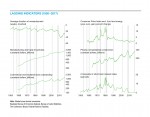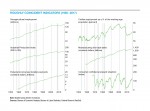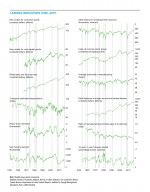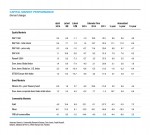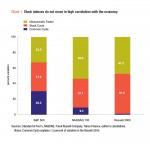June Business Conditions Monthly
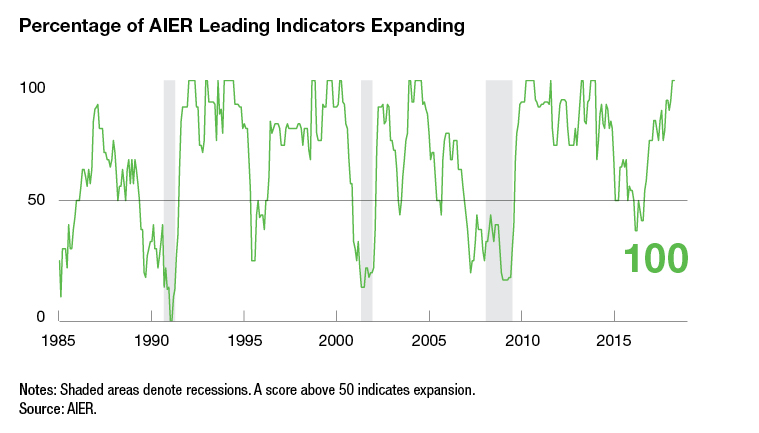
AIER’s Business Cycle Conditions Leading Indicators index posted its third-straight 100 in May as all 12 individual indicators continue to expand. The Roughly Coincident Indicators index also registered its third consecutive perfect 100 and its 12th 100 in the past 15 months. The Lagging Indicators index held at 92, the highest level since February 2017 (see chart below). Together, the AIER business cycle indicators signal economic strength and suggest a positive outlook with a low probability of recession.
Many activity measures have regained momentum over the past month. However, ongoing uncertainty in D.C., particularly over trade policy and tariffs, and rising interest rates are sufficient to warrant adding a note of caution in assessing current economic conditions. The manufacturing sector, while showing signs of strength, is acutely vulnerable to trade and tariff wars causing potentially higher inputs costs and weaker demand. The healthy state of the economy has helped push household net worth above $100 trillion for the first time.
Leading indicators suggest robust economic conditions
The Leading Indicators index maintained a perfect 100 reading in May, marking the first three-peat of 100s since November 2013–January 2014. All 12 indicators continued expanding in the latest month. As noted last month, since 1987, the Leading Indicators index has reached 100 on 16 separate occasions, holding that level an average of 4 months. The longest run of perfect scores was nine months. That record occurred twice, once in 1980–81 and again in 1983. History suggests the Leading Indicators index will be unable to hold the perfect score for very long.
When the leading index is at 100, there is an average of 17.4 months until the next recession, based on data going back to 1957. The conclusion is that the strong reading remains a favorable sign for broad-based economic expansion in the months ahead.
The Roughly Coincident Indicators index recorded its third consecutive perfect 100 and its 12th 100 in the past 15 months. All six indicators have expanded in the latest month. As also noted last month, over its history, the Roughly Coincident Indicators index has shown more persistence than the Leading Indicators index. Since 1987, this index has hit 100 on 22 occasions. The average duration of runs at 100 is 12.5 months, more than three times the duration of perfect runs in the Leading Indicators index. The longest stretch of perfect scores by the Roughly Coincident Indicators index was 57 months, from August 1996 through April 2001.
AIER’s Lagging Indicators index held at 92 in the latest month. Overall, five indicators are trending higher, none are trending lower, and one, commercial and industrial loans, is neutral.
The three AIER business cycle indicator indexes showed strong results again in May, suggesting a continued favorable economic outlook with a low probability of recession in the coming months.
First-quarter GDP revised slightly lower
Revised estimates show real GDP grew at a 2.2 percent pace in the first quarter, versus an initial estimate of 2.3 percent. The revised estimate is below the 2.9 percent pace in the final quarter of 2017. For all of 2017, real GDP grew 2.3 percent compared to a 1.5 percent rise in 2016.
After minor revisions, the take-away from the report remains the same. The deceleration in first-quarter real GDP growth was primarily due to slower growth in real consumer spending. Real personal-consumption expenditures grew at a 1.0 percent pace versus a 4.0 percent rate in the fourth quarter. On the positive side, all major types of spending categories (consumer spending, business investment, net trade, and government expenditure) made a positive contribution in the first quarter.
Another way to measure output is by type of output (goods, services, and structures) rather than type of expenditure. By these measures, real goods spending rose at a 3.2 percent pace in the first quarter versus 2.6 percent in the fourth quarter. Services spending rose at a 1.5 percent pace in the first quarter versus 1.9 percent in the fourth quarter. Spending on structures rose a solid 4.0 percent in the first quarter, well below the 12.2 percent pace of the fourth quarter. The solid pace of growth for goods spending in the first quarter is consistent with other positive data coming from the manufacturing sector (see below).
A variety of updated estimates for second-quarter real GDP suggest an acceleration in growth. Specific point forecasts tend to be fairly inaccurate, but analyzing the movements in broad consensus expectations and forecasts in conjunction with quantitative analysis of the hard data can be informative.
The latest Reuters poll of professional forecasters has a 3.0 percent rate for second-quarter real GDP. The Wall Street Journal survey has an even-more-robust 3.6 percent expectation, about the same as The Blue Chip Economic survey. GDP nowcasts (models that continuously update GDP forecasts based on incoming data) from the New York Fed and the Atlanta Fed show rates of 3.3 percent and 4.5 percent, respectively. While there is no reason to believe that any of these will necessarily be accurate (given the wide range, most will be off substantially), the fact that all are showing a significant acceleration from the first quarter’s 2.2 percent pace adds support for a positive outlook for the economy.
Manufacturing sector appears healthy but remains vulnerable to trade policy and rising materials costs
U.S. manufacturing output rose at a 1.4 percent pace in the first quarter of 2018. That follows a 5.2 percent pace in the fourth quarter of 2017. For all of 2017, manufacturing output rose 1.8 percent. The most recent data show a 0.5 percent increase in April, putting the 12-month change at 1.8 percent. April is the 17th consecutive month of positive year-over-year growth. Despite the improving trend recently, growth still lags the long-term (since 1950) average pace of 3.0 percent. The pace is on par with the 1.7 percent average over the past 30 years.
The short-term outlook appears favorable as new orders at the nation’s factories have been growing at a healthy pace recently. New orders have risen in six of the past nine months. Year to date, new orders are up 8.3 percent versus the same period in 2017. Durable-goods orders are up 9.7 percent over that period while nondurable-goods orders are up 6.9 percent. That pace of new orders versus a slower pace of production has boosted backlogs of orders to $1.15 billion. Year to date, unfilled orders are up 3.7 percent versus last year.
The June Report on Business from the Institute for Supply Management corroborates the statistics. The composite Purchasing Managers’ Index came in at 58.7 for May, up 1.4 points versus April. The index is constructed with 50 being neutral, results above 50 indicating expansion and results below 50 indicating contraction. New orders, production, and employment are all expanding according to the survey. Furthermore, supplier deliveries of input materials are slowing at an increasing rate (a sign of strong demand), backlogs of orders are growing, customer inventories are too low, and price increases of inputs are accelerating. Respondents noted, among other things, that demand remains strong, finding quality labor
is difficult, and they have significant concern over the potential impact of tariffs and rising cost of materials.
Barring a black-swan event, the short-term outlook for the manufacturing sector looks favorable. However, labor availability and materials costs are significant operating risks while trade policy creates significant uncertainty, something most businesses loathe.
Corporate profits are trending higher
Pretax corporate profits in the latest GDP report rose 4.3 percent from the first quarter of 2017, better than the 2.7 percent rise in the fourth quarter of 2017. The broader trend shows a modest deceleration in growth since posting an 8.7 percent rise in the final quarter of 2016.
Taxes on profits dropped 29.6 percent in the first quarter versus the same quarter last year. That drop helped after-tax profits jump 14.0 percent in the first quarter.
Adjusting for NIPA accounting standards to make the numbers more closely reflect private accounting conventions, after-tax profits rose just 0.1 percent over last year. That is better than the 6.0 percent decline in the final quarter of 2017.
The corporate-profit data tend to be volatile period to period. Looking at the three-year annualized growth, after-tax profits without the inventory-valuation and capital-consumption adjustments in the NIPA accounts have been growing at a 2.6 percent pace. While slow by historical comparison, it is still a solid positive trend. That’s important because that measure has turned to a downtrend well before the peaks of the prior three economic expansions.
Labor-market indicators rebound in latest month
The labor market continues to be quite healthy. The economy added 223,000 jobs in May following gains of 159,000 in April and 155,000 in March. That gain puts the average increase in jobs for the past three months at 179,000. The cumulative effect has been to push the unemployment rate down to 3.8 percent as of May, tying the lowest rate since 1970.
Furthermore, the continuing low level of initial claims for unemployment insurance and a record 6.7 million open jobs across the economy point to continued strength in the labor market. That strength is likely to support consumer confidence and support further gains in consumer spending.
Despite the robust labor-market dynamics, wage growth as measured by average hourly earnings remains modest. AHE rose 0.3 percent in May, bringing the 12-month gain to 2.7 percent, in line with the trend over the last two years. Along with rising payrolls and rising AHE, the length of the average workweek held at a relatively long 34.5 hours in May, though overtime hours in the manufacturing sector did ease slightly from 3.7 hours to 3.5 hours.
Nevertheless, combining payrolls with AHE and hours worked, the index of aggregate weekly payrolls, a proxy for take-home pay, rose 0.5 percent in May and is up 5.0 percent over the past 12 months, a pace that is likely to support consumer-spending growth in the future.
Household net worth hits a record in the first quarter
Household net worth (assets minus liabilities) reached an all-time record $100.8 trillion in the first quarter of 2018. Assets rose 0.9 percent to $116.3 trillion while total liabilities rose 0.3 percent to $15.6 trillion.
Contributing to the record-level net worth was an improved personal savings rate. Savings as a share of disposable personal income rose to 7.8 percent on a four-quarter average basis in the first quarter of 2018. The measure calculated in the flow-of-funds accounts is more comprehensive than the measure in the monthly personal-income report that most people tend to quote. That rate stands at just 3.1 percent for the 12 months through April 2018.
Current indicators suggest the U.S. economy is generally healthy, but constant change in the world underscores the need to be vigilant.
[pdf-embedder url=”https://www.aier.org/wp-content/uploads/2018/06/BCM_June_2018.pdf“]